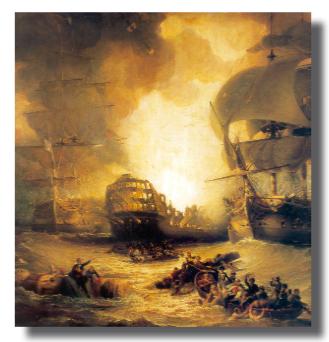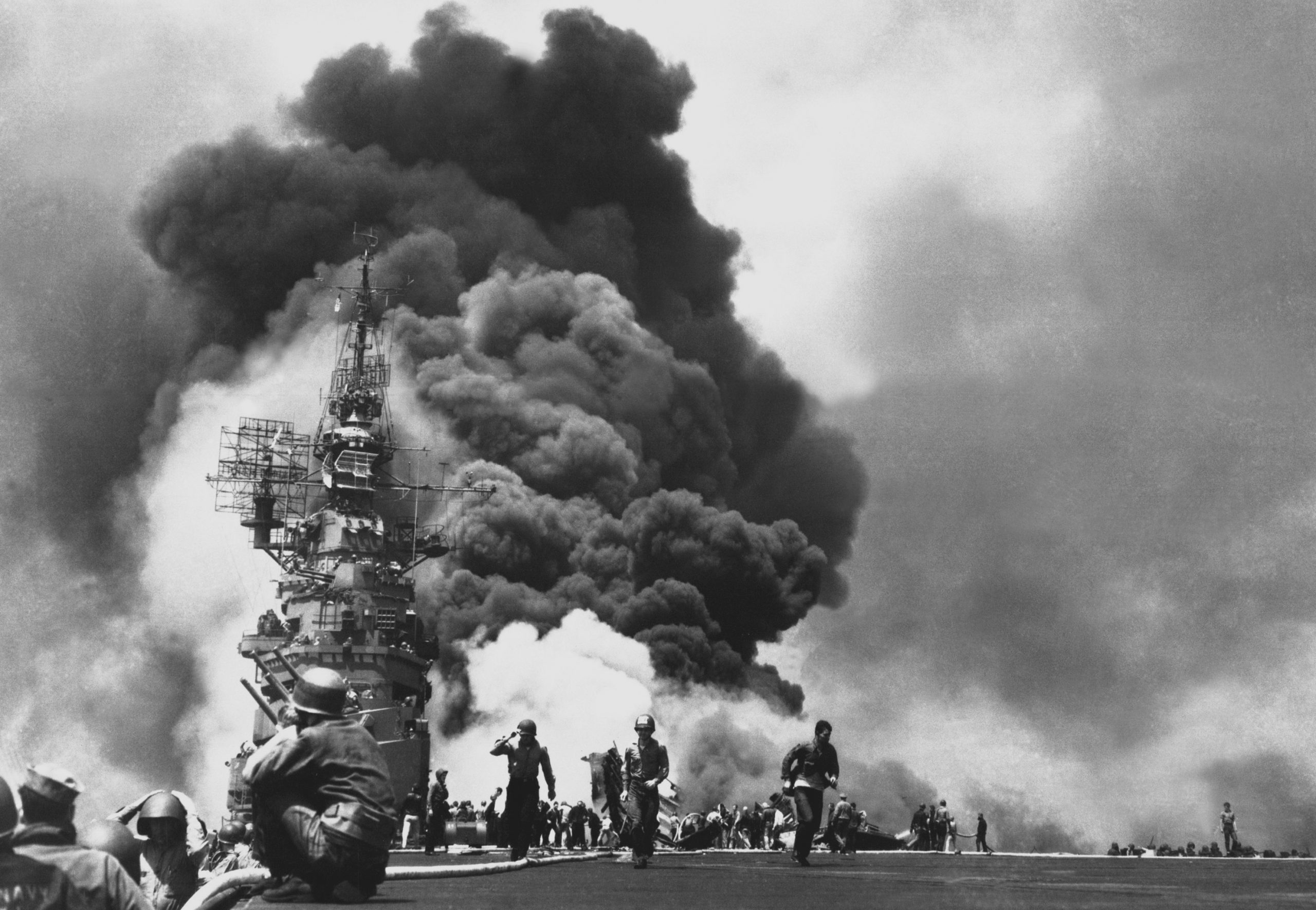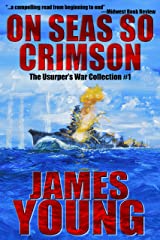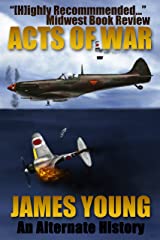*cough cough* Man, it’s kind of dusty in here. You’d almost think someone hasn’t been in this place for like weeks. Oh, wait…
Welcome to another edition of Warship Wednesday. Today, rather than talking about a particular class of vessel, we’re going to talk about something near and dear to ship to ship fights: damage control.
According to Luttwak and Koehl’s The Dictionary of Modern War, damage control is “[m]easures meant to limit or counteract the effects of battle damage. Naval damage control measures include firefighting, counterflooding to reduce listing, the shoring up of damaged bulkheads or hull frames, and ad hoc repairs. The effectiveness of such measures depends on crew training, as well as on design features, such as compartmentalization, duplication of key facilities, the number and location of fire mains, emergency electrical generators, and pumps; such provisions account for a significant portion of warship costs.”
Sounds like some complicated stuff, right? Well, that’s because it is and it isn’t depending on what era you want to talk about. Age of galleys? Damage control was basically, “Oh f*ck, we just got rammed and…dammit, dammit, that’s it, the rowing slaves are screaming, the ship is sinking, and I’m sitting here in a suit of full metal armor getting pointed and laughed at by the asshats who put a hole in the ship.” I mean, this is simplifying it somewhat, but both because the source material is kind of thin on the ground and the art of shipbuilding wasn’t all that and a bag of chips, if someone let Mr. Sea in, Mr. Fish and Mr. Crab were getting fed.
Oh and fire? Yeah… about that. Basically if you had the misfortune of fighting crazy bastards who were not only comfortable with having incendiaries on their vessels but lighting and launching from a pitching ship, you may have chosen enemies poorly. Because if those lunatics hit you and got a good blaze going, especially with something that adhered well to the hull? Well, suddenly that guaranteed trip to to the bottom didn’t seem like such an inconvenience. Something about “Drowning sure beats being the long pork at Mr. Arsonist’s Luau on the Sea…”
It was during the Age of Sail that things both got better and worse as far as damage control went. On the plus side, sturdier ships and actual compartmentalization meant that there was a fighting chance to repair the vessel. Cannons, relatively extended ranges, and improvements in the ability to maneuver (albeit depending on wind) also meant that there was increased time to effect damage control in many cases. Best of all, damage control could “make the magic happen” with your basic carpentry kit and the supplies most sailing vessels kept on hand. Mainsail get carried away because your opponent likes to aim high? That’s cool, the repair process is the same as if you got Neptune’s pimp hand from a storm. Since everyone knew Neptune was gonna want his money sooner or later, repairing / removing masts or filling holes with patches were drills that the crew performed on a regular basis anyway.
On the flip side–gunpowder. As in, things like this could happen:

That’s the French vessel L’Orient going sky high at the Battle of the Nile because of a moderate fire that got out of control. That’s right–you bring gunpowder to a gunfight, suddenly Mr. Fire becomes even more of a jerk about sinking your ship. Given the rudimentary pumps of the day, a fire getting out of control wasn’t all that uncommon. In many cases, the only thing that kept this from happening a lot more often was Mr. Sea won the “How Can We Make a Crew Homeless?”-contest by a few minutes.
Eventually the Age of Sail gave way to the Age of Iron. That, in turn, became the Age of Steel. Since I’m not Avalon Hill and trying to sell you wargames, I’m gonna lump the last two together. (“Just how many ages are there?” “Shhh, shhh…we’re not going to go to the Age of Missiles”) Without getting into a treatise on weapons’ advancement during this time, suffice to say things kind of got to be the suck for damage control during this era. Various nations perfected the means to reliably detonate explosives underwater. At first, this was only possible via fixed means, i.e. what were initially torpedoes (yes, as in “Damn the torpedoes!”) but now are known as mines. Then some genius (often attributed to one Mr. Whitehead, but there are others), figured out how to add propulsion–and thus the modern torpedo was born.
“But wait a second–I thought large warships had compartmentalization just to keep a single underwater hit from doing it in?” Yeaaaaahhh, about that. In theory, yes. But funny thing about mines and torpedoes–they seldom seem to hit just one compartment. For example, the British battleship H.M.S. Audacious, barely a year old and with the most advanced compartmentalization of the time, took a mine hit that opened up multiple compartments at once. This, in turn, led to “progressive flooding,” which is basically water finding all those passageways that have to left open for a warship to be able to function even at General Quarters. Even with good compartmentalization, a vessel that has three or four major spaces open to the sea will be swiftly in danger of capsizing. Throw in the secondary effects of a torpedo hit (e.g., fires, power disruption, bulkhead distortion, etc.), and its easy to see where things get hairy.
Modern gunfire also posed a much larger problem as far as damage potential went. Outside of the “Golden BB” of a shell going into the magazine (think L’Orient, but instantaneous), there was also the problem of shells passing through the ship’s armored belt or deck and hitting major systems. What do I mean by major systems? Oh, little things like flooding oil tanks, hitting the electrical generators, or sending the central communications box to Kingdom Come. These were all things that could and did happen in the midst of chaotic naval fights, and it was often a life or death matter for the crew to do so. After all, everyone likes a simple gunnery solution, and if the rudder wasn’t working that made things easy peasy for everyone shooting at one’s ship. (The crew of the K.M.S. Bismarck are all nodding sadly at this.)
So how did crews save themselves and their ships? Well, as in the Age of Sail, in both World War I and II most vessels had a kit put together with things like “collision mats,” dimensional lumber. This was buttressed by improvised stopping materials like crew hammocks or mattresses shoved into a hole. By the end of World War I, ship builders began to add things like multiple pumping stations to aid in getting water out of the vessel, followed by making some of these stations multi-functional in order to help get water into the vessel in order to fight fires. Although the Battle of Jutland was the only major fleet engagement, there was more than enough data from that incident to provide ship builders with thoughts on what went well (“Jolly good, the magazine flooding worked well on Lion…”) versus what went poorly (“Bloody hell, we really need to figure out better flash doors…”).
At the beginning of World War II, ship design had made another evolutionary lurch forward based on the threat of modern aircraft and submarines. Unfortunately, as became quickly apparent, damage control was still very hit or miss. The British lost the carrier Ark Royal to a single submarine torpedo despite being fairly close to their base at Gibraltar, and had several other vessels succumb to levels of damage their sister ships would later survive. The Italians, while not quite as incompetent as some sources like to portray them, seemed positively fatalistic when it came to what mitigating actions should be performed. The Japanese Navy’s relative indifference to damage control (with a few exceptions–see IJNS Shokaku‘s longevity) meant that their fleet units were knocked out longer when hit or, in all too many cases, had major damage become mortal due to officer incompetence (see IJNS Taiho). In short, damage control success / failure for most navies became as much a matter of how seriously the captain and executive officer took things prior to the hit as said strike’s location.
The massive exception to this was the United States Navy. This is not to say that the USN was inherently better from start to finish. Indeed, this was inherently not the case. Given that the USN started the war after its major ally (the RN) had been taking knocks for over two years and sharing the information about said beatdowns, the Navy’s early war performance was shockingly abysmal. Pearl Harbor (surprise attacks are always bad) and the Asiatic Fleet (overwhelming force) can be eliminated from the narrative. However, from Coral Sea through the end of the Guadalcanal campaign, the Pacific Fleet lost at least four major combatants (Lexington, Yorktown, Astoria, and Northampton) due to damage control miscues when all four vessels could have been potentially saved. Other vessels were saved more through good fortune than necessarily excellent damage control work. In short, the IJN took the USN behind the School of Hard Knocks and proceeded to take their lunch money, their glasses, and their dignity.
The difference between the USN and most of its contemporaries is that the USN learned. The Department of the Navy collated all of the loss and damage reports and proceeded to distribute them regularly to the fleet. It forced officers and ratings to attend damage control schools and training until every member of the regular crew had at least been exposed to some degree of what to do when the ship got hit. It leveraged the United States’ incredible industrial advantage to produce literally thousands of portable pumps, breathing apparatus, hoses, and fire fighting equipment to issue to its ships. Finally, ship designs were changed while on the ways to improve fire main survivability, add sprinklers, and otherwise make it easier for a vessel to survive when hit by a torpedo or bomb.
Did it work? Yes. One need look no further than comparing the damage that put paid to the Yorktown at Midway versus the utter mauling suffered by the U.S.S. Franklin (newsreel footage here as well) and Bunker Hill. To their horror, the Japanese found themselves facing the nautical equivalent of Jason Vorhees, as ships they were certain they’d sunk just kept coming back…and back…and back again. Meanwhile, especially after the USN got its torpedoes to work, their vessels were getting sunk or knocked out of the war by one or two major hits due to their failure to propagate lessons.
So how does this all translate into writing? The obvious is that if you’re writing historical fiction and placing your character aboard a vessel, do a quick Wiki sweep to see what happened. If you’re doing alternate history, feel free to extrapolate actual ship damage in a notional battle that is analogous to what happened to a sister ship or similar size combatant in that navy. For science fiction, read through some of the war reports and get a sense of how vessels die, then realize that vacuum and advanced systems add “special sauce” to what you can do to place your characters in peril. Being an author means one gets to play a deity…and we all know deities aren’t always benevolent.
UPDATE: Please see a video that expands upon the lessons above.




Interesting stuff! I love your Usurper’s War books, looking for more.
Thanks! I’m going to be knocking out the sci-fi next, but there will definitely be more to come.
Awesome content here. Very well presented. Fascinating material.
I will be following. Thanks
http://sharemoneyideas.wordpress.com